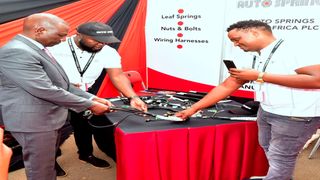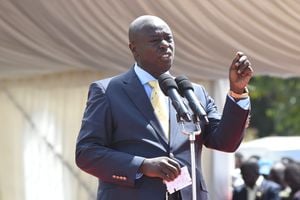
Auto Springs East Africa Engineers Ken Kadimah and Stephen Wambua explain their products to President William Ruto during the launch of Isuzu East Africa 1st ever-electro-deposition paint plant in sub-Sahara Africa at their headquarters in Nairobi on June 7, 2023, to boost local vehicle production capacity and eco-friendliness.
| Lucy Wanjiru | Nation Media GroupKenya@60
Premium
The chequered journey of Kenya’s manufacturing growth
Kenya has a relatively large and diversified manufacturing sector that largely serves the East African region.
The sector has developed from the basic production of food and beverages 60 years ago to more advanced industries.
The manufacturing sector, though dominated by subsidiaries of multinationals such as America’s Coca-Cola and Britain’s Diageo, has 14 sub-sectors.
These include food, beverages and tobacco; textile and apparel; leather and footwear; metal and allied; chemical and allied; pharmaceutical and medical equipment; plastics; light engineering; furniture; motor vehicles and parts.
The journey has not been smooth, nonetheless.
Kenya’s march towards industrial development is as old as independence. It started in earnest after the first independent government adopted import substitution industrialisation policies which had started during the colonial time.
While the pre-independent policies were largely aimed at supporting economic development and supply of raw materials to the colonial powers, the post-independent strategy was adjusted to suit the production of basic products for Kenya and her neighbours who later joined the East African Community.
The industrial development pursued by the Jomo Kenyatta administration from the early 1960s through the 1970s largely revolved around import restrictions, high import duty rates, foreign exchange controls and interest subsidies to manufacturers.
While the protectionist policies delivered high growth for the manufacturing sector in the 1960s, they were blamed for “encouraging the excess capacity and generalised inefficiency that undermined the ability of Kenyan products to penetrate external markets”.

President William Ruto and US Ambassador to Kenya Meg Whitman witness the Investment, Trade and Industry CS Moses Kuria and PS Investment Promotion, Abubakar Hassan Abubakar sign a bilateral agreement with a US Firm Moderna to build a Sh65 Billion mRNA manufacturing facility in Kenya during the American Chamber of Commerce Regional Business Summit in Nairobi on March 30, 2023.
This was captured in a paper titled Kenya’s Industrial Development: Policies, Performance and Prospects authored by Dianah Ngui, Jacob Chege and Peter Kimuyu, and published in 2016 by Oxford.
EAC collapse
Following the collapse of the EAC in 1977, Kenya removed the import restrictions, reduced import duty and liberalized the foreign exchange market with the goal of promoting export-led manufacturing.
In the 1980s and 1990s, manufacturing was among the key sectors which were hardest hit by the structural adjustment programmes spearheaded by the World Bank (WB) and International Monetary Fund (IMF). The reforms were largely aimed at ending government controls on many economic sectors and reforming parastatals. The resultant market liberalisation policies raised the cost of production, shaking the manufacturing sector and cutting its competitiveness.
Some manufacturers closed down factories and moved production to other countries, while others became importers of goods they hitherto produced. Successive governments have since failed to adequately address the competitiveness of Kenya’s manufacturing sector resulting in the proliferation of basic products from other countries.
Sixty years since independence, manufacturers still complain of a lack of facilitative infrastructure, citing the high cost of energy as one of the key dampers to competitiveness.
They have over the years largely blamed costly power as well as multiple and unpredictable taxes and levies for the low competitiveness of Kenyan-made products globally and the relocation of factories to other countries, hurting the creation of jobs for skilled youth.
“Kenyan products are competing with products from all over the world. And, therefore, we need both as a country and at the firm or factory level to be globally competitive, so that we can compete with the best in the world, including the Chinese, Indians, Koreans, Taiwanese and Vietnamese who are not sleeping,” Antony Mwangi, the chief executive of Kenya Association of Manufacturers, said in a recent interview.

From left- Coca-Cola Beverages Africa (CCBA) manufacturing director Duncan Kimani, then-President Uhuru Kenyatta (centre) and his deputy William Ruto during the opening of Coca-Cola Beverages Africa (CCBA) - Kenya Hotfill Juice Line of a Sh7 billion at its Nairobi Bottling Plant in Embakasi Nairobi on May 15, 2018.
“If you look at some of the products that we sell like apparel, even with the duty-free access to the US markets, we are still 15 to 20 per cent more expensive than our competitors in the Far East or Central Asia like Bangladesh and Sri Lanka. Why? Power, water and labour in Kenya are very expensive.”
East Asian economies
Kenya’s industrial development plan has largely sought to borrow from East Asian economies’ industrial revolution which invested heavily in labour-intensive, low-technology manufacturing activities which helped catapult them to sustainably high economic growth between 1965 and 1990.
Countries such as Japan, South Korea, Taiwan, Hong Kong, Singapore, Thailand, Malaysia, and Indonesia dramatically grew their real per capita gross domestic product – economic output divided by the number of people and adjusted for inflation– in that period.
That helped cut poverty and income inequalities in what has come to be known as the “East Asian Miracle”.
President William Ruto, just like his predecessors, has placed manufacturing at the top of his Bottom-Up Economic Agenda which is “geared towards economic turnaround and inclusive growth”.
The Ruto administration has pledged to raise the manufacturing sector’s contribution to the gross domestic product — a measure of national economic output— from 7.8 per cent in 2022 to 20 per cent by 2030.

Former President Mwai Kibaki during a tour of Mitsimoto Motor Company exhibition by Mr Vimal Shah, Chairman of the Kenya Association of Manufacturers (KAM) during its 50th anniversary at a Nairobi Hotel in 2010.
Dr Ruto’s ‘Kenya Manufacturing Agenda 20 by 30’ aims at maximising “opportunities available to spur local industry’s growth”.
“In the next five years, I want it to be at 15 per cent [and] by 2030 I want manufacturing as a percentage of our GDP to be at 20 per cent. That is the trajectory I want us to go,” Dr Ruto told a joint media session on May 14. “In this budget [for the financial year starting July], we have imposed [higher] taxes … on imported fish, furniture, steel, cement [et cetera] because we want to grow our own manufacturing capacity. By growing our own manufacturing capacity, we grow jobs.”
The Kenya Kwanza’s target for the manufacturing sector appears overly ambitious given that the predecessor regime failed by far to achieve the 15 per cent share of GDP for the manufacturing sector.
The Kenyatta regime, in which Dr Ruto served as a powerful Deputy until his powers were clipped in 2019, had pledged to pursue export-oriented manufacturing agenda with a focus on value-addition to farm produce. In fact, Dr Ruto was the one who graced the launch of the Integrated National Exports Development and Promotion Strategy (NEDPS) on July 31, 2018.
The sector’s share of the GDP, however, shrank from 8.4 per cent in 2018 to 7.9 per cent in the year that followed, 7.6 per cent (2020) and 7.4 per cent (2021), before recovering to 7.8 per cent last year.
The thinning share of the industrial sector to national economic output largely reflected slower growth than services such as transport, ICT and financial services.
The sector’s output slowed from 6.7 per cent in 2018 to 3.0 per cent in 2019, 0.2 per cent (2020), and 6.5 per cent (2021), before slowing to 3.8 per cent in 2018, according to Economic Survey 2023.
Kenya Institute for Public Policy Research and Analysis (Kippra) researchers Vincent Okara and Brian Obiero, in a past discussion paper titled Labour Demand in Kenya: Sectoral Analysis, largely blamed high operating costs, rising informal industries and inadequate funding for curtailing growth in the manufacturing sector.
“Given that MSMEs (micro-, small- and medium-sized enterprises) form a good proportion of firms in the manufacturing sector, there are some challenges they face that are related to technological issues. In addition to the cost of energy and finance, Kenya is facing significant competition from the region because we have decided not to move from low-level technology activities,” Kippra executive director Rose Ngugi said in a past forum. “You are producing a product and selling it to Uganda which has now decided they are now going to produce that product on their own.”
The sector, however, holds the biggest potential for creating decent jobs for Kenya’s exploding skilled youthful population.
Jobs in the manufacturing sector stood at 352,600 last year, a 4.69 per cent growth from 336,800.





